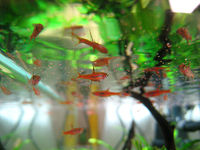How To Care For Mosquito Rasbora
Mosquito Rasboras are small, colorful freshwater fish that add charm to any aquarium. They thrive in well-kept environments and are relatively easy to care for. A key aspect of their care is maintaining stable water conditions, as they are sensitive to sudden changes. These fish prefer a temperature range of 72-78°F (22-26°C) and a slightly acidic to neutral pH level between 6.5 and 7.5. Regular water changes help ensure that toxins do not build up, keeping the environment healthy for your rasboras.
Providing a tank with plenty of swimming space and hiding spots is essential. Mosquito Rasboras are active and enjoy exploring their surroundings. Adding plants and decorations not only enhances their habitat but also helps simulate their natural environment, which can reduce stress and promote natural behaviors.
Though small, Mosquito Rasboras are social creatures that do well in groups. Keeping them in schools will make them feel secure and display their vibrant colors more effectively. Regular monitoring of water parameters and ensuring a clean environment will help these fish flourish and remain a lively addition to your aquarium.
Mosquito Rasbora is a fascinating aquarium fish that stands out with its vibrant colors. It belongs to the family Cyprinidae and is native to the Indonesia.
This species has a care level of Moderate and requires a minimum tank size of 38 Litres (10 US G.). It typically reaches a size of 1.3-1.8cm (0.5-0.7 ").
Preferred water parameters include a specific gravity (sg) of Freshwater, pH ranging from 6.5 - 7.0, and a temperature between 25 -28 °C (77-82.4°F). Additionally, maintaining water hardness within the range of 8-10 °d is essential.
For stocking, the recommended ratio is 1:2 M:F. The Mosquito Rasbora is widely available and has a diverse diet that includes OmnivorePellet FoodsFlake FoodsLive Foods.
With a life span of 4-8 years, this species is known for its very easy care requirements. It is an ideal choice for both beginner and experienced aquarists. Providing a well-maintained tank environment with suitable water conditions will ensure the health and vibrancy of this captivating species.

